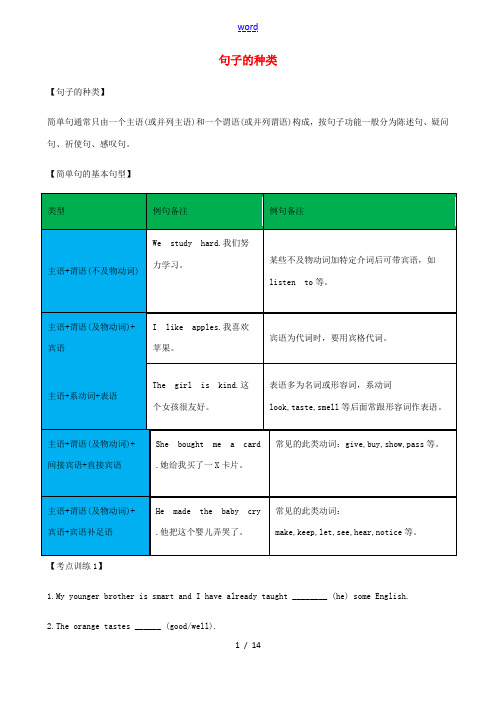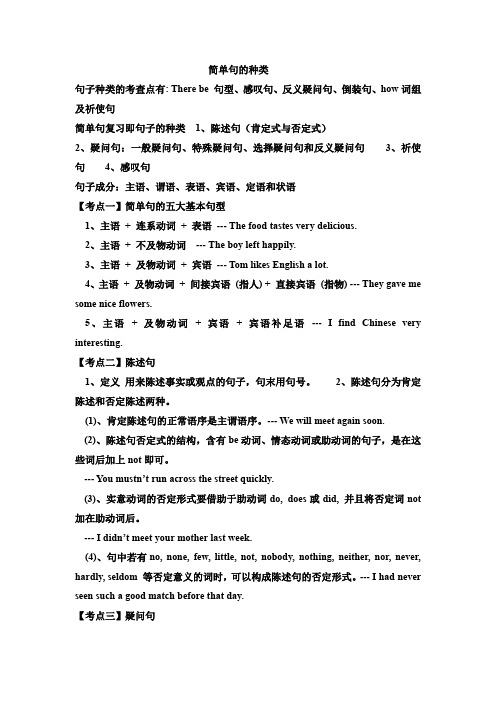中考英语--专题复习-- 简单句四种类型
- 格式:doc
- 大小:201.50 KB
- 文档页数:19

初中英语“简单句”专题讲解(一)基本概念只包含一个主语(或并列主语)和一个谓语(或并列谓语)的句子,称作简单句。
在简单句中主语和谓语是句子的主干,是句子的核心。
除了主语和谓语外,简单句中还可以有宾语、表语、补语、状语、定语等。
(二)句型结构简单句可归纳为五个基本句型。
1.主语+谓语这种句型简称为主谓结构,其谓语一般都是不及物动词,后面可以有其他成分修饰。
如:T h i n g s c h a n g e.H e s m i l e s h a p p i l y.2.主语+连系动词+表语这种句型称为主系表结构。
如:M r.S m i t h i s a n a r t i s t.T h e h a m b u r g e r t a s t e s g o o d.注:表语位于系动词之后。
常由名词、形容词、副词、介词短语、不定式、动词的-i n g、从句来充当。
常见系动词有:(1)表状态系动词---b e如:H e i s a t e a c h e r.H e i s i l l.(2)持续系动词--用来表示主语继续或保持一种状况或态度,常见有k e e p,r e m a i n,s t a y,如:H e a l w a y s k e p t s i l e n t。
(3)表像系动词--用来表示"看起来像"这一概念,主要有s e e m, a p p e a r,l o o k,如:H e l o o k s t i r e d.H e s e e m s(t o b e)v e r y s a d.(4)感官系动词---感官系动词主要有f e e l,s m e l l,s o u n d, t a s t e,如:T h i s k i n d o f c l o t h f e e l s v e r y s o f t.。

英语简单句五种基本句型和三种必考句型总结前五个句型属于简单句的基本句型,后面三个是中考中重要的简单句句型,最后面是句子成分的名词解释。
掌握好简单句是学好语法的基础,同学们要重视哦!一. 五种简单句基本句型1.“主语 + 谓语”(即“主谓”句型)这一句型英汉语言结构形式完全相同,说明“某人或某物如何动作”,或者说“某人或某物自身怎样运动”。
例:They arrived in Harbin yesterday morning.分析:“they”(主语)“arrived”(谓语)。
2.“主语+ 谓语+ 宾语”(即“主谓宾”句型)这一句型英汉语言的结构形式完全相同,用以说明“某人或某物做什么事情”,或者说“某人或某物发出了动作,并且其动作涉及到另一个人或物”。
例:I study English.分析:“I”(主语)“study”(谓语动作)“English”(宾语即动作涉及的对象)。
3.“主语 + 谓语 + 间接宾语 + 直接宾语”(即“主谓双宾”句型)这一句型英汉语序结构相同,说明“某人为谁(间接宾语为人)做某事”,或者说“某人或物的运动涉及到两个对象,其中一个间接对象为人,另一个为物”。
例:Our teacher taught us English.分析:“our teacher”(主语)“教”(谓语动作)“us”(间接宾语)“English”(直接宾语)。
4.“主语 + 谓语 + 宾语 + 宾语补足语”(即“主谓宾宾补”句型)这一句型说明“某人或某物要求(使、让)某人做什么”或“某人感觉某人或物怎么样”。
例:He asked her to go there.分析:“he”(主语)“asked”(谓语动作)“her”(宾语即动作涉及的对象)“to go there”(补语—补充说明宾语做什么)。
5.“主语 + 系动词+ 表语”(即“主系表”句型)这一句型用以说明“某人(某物、某事、某种概念)具有什么特征或处于什么状态”。


句子的种类【句子的种类】简单句通常只由一个主语(或并列主语)和一个谓语(或并列谓语)构成,按句子功能一般分为陈述句、疑问句、祈使句、感叹句。
【简单句的基本句型】【考点训练1】1.My younger brother is smart and I have already taught ________ (he) some English.2.The orange tastes ______ (good/well).3.Loud music always makes me _____ (want) to dance.答案:him good want【陈述句】注意:否定句是在be动词、助动词或情态动词后加not,常用缩略形式,要注意人称、时态的一致。
【考点训练2】1.I woke up early in the morning.(改为否定句)I ____________ up early in the morning.2.Carrots are grown all over the world.(改为否定句)Carrots ______________all over the world.3.They have gone to Africa.(改为否定句)They __________________ to Africa.答案:didn’t wake aren’t grown haven’t gone【疑问句】◆常见疑问词(组)及其用法常用来询问交通方式;答语中出现by+v.ing时,一般用how来提问。
【考点训练3】1.—____ you ever ____ to Shanghai?—Yes,I went there last year. ()A.Are;goingB.Do;goC.Did;goD.Have;been2.—___ are you going to England?—To visit my uncle.He lives there with his family.()3.—Do you like listening to country music or rock music?—____.It brings me pleasure. ()A.Yes,I doB.No,I don’tC.I like musicD.Country music4.David never fights with his classmates,____? ()’t he’t he答案:DCDA祈使句祈使句表示请求、命令、劝告、叮嘱、号召、建议等。

简单句的种类句子种类的考查点有: There be 句型、感叹句、反义疑问句、倒装句、how词组及祈使句简单句复习即句子的种类1、陈述句(肯定式与否定式)2、疑问句:一般疑问句、特殊疑问句、选择疑问句和反义疑问句3、祈使句4、感叹句句子成分:主语、谓语、表语、宾语、定语和状语【考点一】简单句的五大基本句型1、主语+ 连系动词+ 表语--- The food tastes very delicious.2、主语+ 不及物动词--- The boy left happily.3、主语+ 及物动词+ 宾语--- Tom likes English a lot.4、主语+ 及物动词+ 间接宾语(指人) + 直接宾语(指物) --- They gave me some nice flowers.5、主语+ 及物动词+ 宾语+ 宾语补足语---I find Chinese very interesting.【考点二】陈述句1、定义用来陈述事实或观点的句子,句末用句号。
2、陈述句分为肯定陈述和否定陈述两种。
(1)、肯定陈述句的正常语序是主谓语序。
--- We will meet again soon.(2)、陈述句否定式的结构,含有be动词、情态动词或助动词的句子,是在这些词后加上not即可。
--- You mustn’t run across the street quickly.(3)、实意动词的否定形式要借助于助动词do, does或did, 并且将否定词not 加在助动词后。
--- I didn’t meet your mother last week.(4)、句中若有no, none, few, little, not, nobody, nothing, neither, nor, never, hardly, seldom 等否定意义的词时,可以构成陈述句的否定形式。
--- I had never seen such a good match before that day.【考点三】疑问句1、含义:用来提问的句子叫疑问句,句末用问号。

简单句的种类英语句子按结构可分为三类:简单句,并列句和复合句:1、简单句Simple Sentences含有一个主语(或并列主语)和一个谓语(或并列谓语)的句子。
e.g. He often reads English in the morning.Tom and Mike are American boys.2、并列句Compound Sentences包含两个或两个以上主谓结构的句子且句子之间有并列连词and/but等或用分号连接。
e.g. You help him and he helps you.The future is bright; the road is tortuous.3、复合句Complex Sentences包含一个主句和一个从句或一个主句和多个从句的句子,且从句用从属连词引导。
定语从句,状语从句,名词性从句都是复合句。
e.g. The foreign visitors took a lot of pictures when they were at the Great Wall.按照句子的功能,简单句可分为4类:陈述句,疑问句,祈使句,和感叹句。
一、陈述句——用来陈述一件事或表达一种看法。
1.肯定式:主语+谓语+……I came here last night. 我是昨晚到这儿的。
The earth turns around the sun. 地球绕着太阳转。
We have many friends. 我们有很多朋友。
Zhang Hong likes dancing. 张红喜欢跳舞。
2.否定式:如果句子的谓语动词是be/have或有助动词和情态动词,在它们之后加not 构成否定式。
China is not a developed country. 中国不是一个发达国家。
He hasn’t been to Hangzhou. 他没去过杭州。
We can’t live without air. 没有空气,我们就不能生存。
初中英语语法总结一、简单句1、简单句的特点:简单句通常只由一个主语(或并列主语)和一个谓语(或并列谓语)构成。
2、简单句的种类:简单句一般分为陈述句、疑问句、感叹句和祈使句四种。
3、陈述句:用来说明一个事实的句子叫陈述句。
它有肯定式和否定式两种形式。
▲陈述句的肯定式:He is a middle school student.(他是个中学生)/ I have a hammer in my hand.(我手上有把锤子)/ She teaches us geography.(她教我们地理)/ The new play was good enough and everybody enjoyed it.(新的话剧非常好大家都喜欢)▲陈述句的否定式:1)谓语动词如果是to be 、助动词、情态动词时,在它们的后面加“not”。
如:My brotheris not a teacher.(我的弟弟不是教师)/ He does not have a cousin.(他没有堂兄弟)/ I will not go there tomorrow.(明天我不去那儿)/ My mother is not cooking a meal inthe kitchen.(我母亲现在不在厨房里做饭)/ You must not make such mistakes again.(你不该再犯类似错误了)/ We haven’t discussed the question yet(我们还没有讨论那个问题呢).2)谓语动词如果没有上述词语而是其他动词时,须在它的前面加do not(don’t).如:Idon’t know anything about it.(此事我一无所知) / Li Ming does not feed pigs in thecountryside.(李明不在农村养猪)/ We didn’t expect to meet her right here.(我们没指望着在这里见到她)/ We didn’t have a meeting yesterday afternoon.(昨天下午我们没有开会)3)如果“have”作“有”讲,也可以在它后面加not构成否定式,其形式与have got的否定式相同。
初中英语中考语法:简单句和并列句的⽤法总结简单句,并列句Simple Sentence & Compound Sentence I本章要点II简单句语法点分述定义由⼀套主谓结构构成的句⼦叫简单句。
简单句分为4类:陈述句,疑问句,祈使句,感叹句。
⼀、简单句的否定形式1.全部否定:neither, neither…nor, none, nothing, nobody, no onea.两者之间⽤neither of, neither…nor他们两⼈没⼈懂英语。
玛丽和约翰都不住在这⾥。
b.三者及以上⽤none of, nothing, nobody, no one这些答案没有⼀个是对的。
没有⼈同意你所说的。
2.部分否定:both, all, many, every…not他们两⼈不都去开会。
闪光的未必都是⾦⼦。
All that glitters is not gold.3.使⽤否定副词表⽰否定,否定副词有:rarely, hardly, nearly, few, little, seldom, scarcely,never我从来都不喜欢看《⽣活⼤爆炸》。
他⼏乎不会说英语。
4.否定转移,常常与believe, expect, imagine, suppose, think连⽤我们相信他做不到。
We that he do it.(详见宾语从句中相关语法解析)⼆、简单句的特殊疑问句形式1.who, whose为句⾸作主语,本⾝已经是陈述句语序了。
Who is in the classroom?Whose father works in Beijing?2.含有插⼊语的特殊疑问句的结构。
特殊疑问词+do you think/do you suppose/do you say+陈述句When do you think he will come? (他会来)你刚提到他是做什么⼯作的?三、简单句的否定疑问句形式回答永远是以事实为依据,肯定yes, 否定no她不是个医⽣吗?不,她是。
中考英语--专题复习-- 简单句四种类型简单句的四种类型一.按要求回答问题。
1.There is only one problem.否定句:__________________________________________一般疑问句:________________________________________肯定/否定回答:____________________________________2.She has some bread for lunch today.否定句:__________________________________________一般疑问句:_________________________________肯定/否定回答:____________________________________ .3.He has three different colored pencil-boxes.否定句:__________________________________________4. Sue did her homework last night.否定句:__________________________________________5. There're some new machines in the house.一般疑问句:_________________________________二.单项选择。
1. She is a good student, _____ she?A. isB. isn’tC. doesD. doesn’t2. -_____ do you go to the park?-Once a year.A. How oftenB. How longC. How soonD. How many times3. -_____ books do you have?-Oh! I can’t remember the number, but a lot of them.A. WhatB. WhichC. How manyD. How much4. Let’s have a rest, _____?A. won’t youB. will youC. don’t youD. shall you5. -_____ did you move to Paris?-Because my father found work there.A. WhyB. WhenC. WhereD. How【相似题练习】一.按要求回答问题。
1.This is a bike under the tree. (否定句,一般疑问句,并作肯定和否定回答。
) 2.She has some story-books. (否定句,一般疑问句,并作肯定和否定回答。
)3. It is quite a nice present. (改为感叹句)4. The fish is very lovely. (改为感叹句)5. Let us go to the cinema together, _____ _____? )(完成反意疑问句)二.选出正确选项。
1. He hardly hurt himself in the accident, _____?A. doesn’t heB. didn’t heC. did heD. does he2. The poor man needs our help, _____ he?A. needB. needn’tC. doesD. doesn’t3. Alice has to finish her work now, _____ she?A. hasB. hasn’tC. doesD. doesn’t4. A sign with the words“____” is often found in a bus.A. Not parkingB. Not smokingC. No parkingD. No smoking5. The robot can help me sweep the floor. _____ smart invention it is!A. WhatB. What aC. What anD. How【知识链接】(1)陈述句(2)疑问句(3)感叹句(4)祈使句【知识梳理】1.简单句的特点:简单句通常只由一个主语(或并列主语)和一个谓语(或并列谓语)构成。
2.简单句根据使用目的一般可分为四类:陈述句、疑问句、感叹句和祈使句四种。
一.陈述句:用来说明一个事实的句子叫陈述句。
它有肯定式和否定式两种形式。
1.陈述句的肯定式:主语+谓语(+其他)eg: He is a middle school student.(他是个中学生)She teaches us geography.(她教我们地理)2.陈述句的否定式:(1) 谓语动词如果是be动词、情态动词时,在它们的后面加“not”。
结构为:主语+be/情态动词+not+其他eg:My brother is not a teacher.(我的弟弟不是教师)He can not swim.(他不会游泳)(2) 谓语动词如果没有上述词语而是其他动词时,须在它的前面加do not(don’t)/ does not (doesn’t)/ did not (didn’t)。
结构为:主语+ do not(don’t)/ does not (doesn’t)/ did not (didn’t)+动词原形+其他eg: I don’t know anything about it.(此事我一无所知)We didn’t have a meeting yesterday afternoon.(昨天下午我们没有开会)(3) 如果“have”作“有”讲,也可以在它后面加not构成否定式,其形式与have got的否定式相同。
eg:I haven’t (got) any brothers or sisters.(我没有兄弟姐妹)(4)[注意]①句子中如果有all、both、very much/well等词时,用not一般构成部分否定,如果要完全否定,则通常使用none、neither、not…at all等;All of them went there.→None of them went there.(他们全都去了那里→他们全都没去那里)②句子中含有little、few、too(太)、hardly、never、neither、nor、seldom等词时, 则视为否定句。
eg:Few people live there because life there is very hard.(几乎没有人生活在那里因为那里的生活太艰难了)③陈述句(主语+谓语+其他)在口语中可以直接表示疑问,表示惊讶或明知故问。
eg:That’s your boss?(那就是你的老板?!)④陈述句一般情况下应使用正常的语序,即:主语+谓语+其他。
但是有时会倒装,详见“倒装句”。
⑤所有的从句一律使用陈述句语序,即在连接词后采用“主语+谓语+其他”的顺序。
eg:The old man told me that he would live here for ten more years before he returns home. (老人告诉我说他还要在这儿住几年然后回家)Could you tell me who you saw at the party last night?(能告诉我在聚会上你都看见了谁吗?)二.疑问句:1.一般疑问句:用“yes”或“no”来回答的疑问句叫做一般疑问句。
(1)一般疑问句构成:①句中谓语动词是be动词、情态动词时,则将它们(提前)放到主语前面。
其结构为:Be/情态动词+主语+其他;eg:Is he an engineer?(他是工程师吗?)Can you explain it ?(你能解释它吗?)②谓语动词如果没有上述词语而是其他动词时,则在主语前面加助动词do/ does/ did, 原来的谓语动词改为原形。
其结构为:Do/ Does/ Did+主语+动词原形+其他eg:Do you get up at six every morning?(你天天早晨六点起床吗?)(2)一般疑问句的回答:一般疑问句通常用简略形式来回答, 回答时所用的时态应和问句里的时态一致。
eg:①—Will you join us in playing basketball?(你们加入我们打篮球好吗?)—Yes, we will.(是的我们会。
)/ —No, we won’t.(不我们不会。
)②—Have you got today’s newspaper?(你有今天的报纸吗?)—Yes, I have .(是的有。
)/ —No, I haven’t.(不没有。
)(3)一般疑问句的否定结构(即否定形式的一般疑问句)表示惊奇、责怪、建议、看法等,只要将“not”置于主语之后或者将“not”放到主语之前与be, have等助动词或情态动词合并在一起就可以了。
eg:Isn’t your sister a Party member?(你的姐姐不是党员吗?)这种否定结构的疑问句的回答与汉语的习惯不同。
如果回答是肯定的,就用“yes+肯定结构”;如果回答是否定的,就用“no+否定结构”。
(情况与反意问句类似。
)如:—C an’t he answer the question? (他不能回答这个问题吗?)—Yes,he can.(不,他能回答这个问题。
) —No,he can’t. (是的,他不能回答这个问题。
)2.特殊疑问句:要求具体回答的问句。
(1) 特殊疑问句结构是:eg:What do you want?Whose magazine is this?(这是谁的杂志?)When did you get up this morning?(你今早什么时候起身的?)但是,“who”引出的询问主语或主语部分相关词的特殊疑问句的结构与陈述句词序相同: eg:Who is dancing over there?(谁在那边跳舞?)有时“what”,“which”,“whose”也可以引出与陈述句词序相同的特殊疑问句。
如:What is on the wall?(什么东西在墙上?/墙上有什么?)/ Which is yours?(哪个是你的?)/ Whose book is in your bag?(谁的书在你的书包里?)[注意]从陈述句改为特殊问句时,先将句子改为一般问句,再将(划线)提问部分更改为疑问词置于句首,特别要注意助动词的使用!如果只对主语或主语的修饰词提问,那么只需要将疑问部分改为疑问词即可。